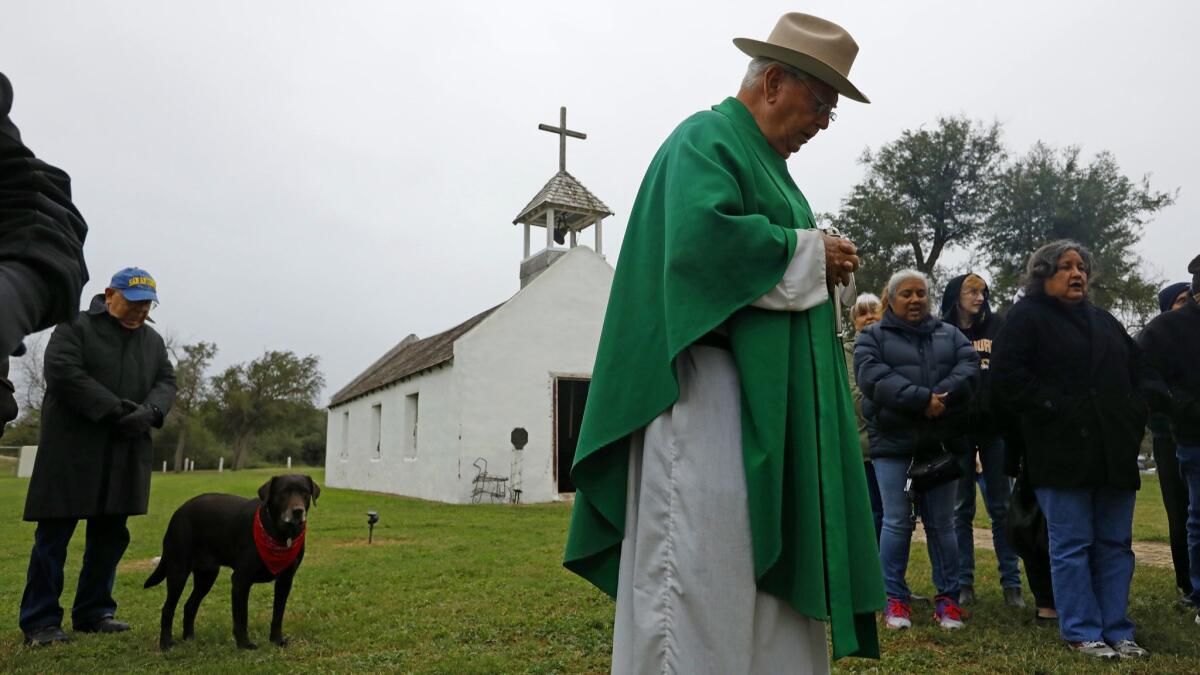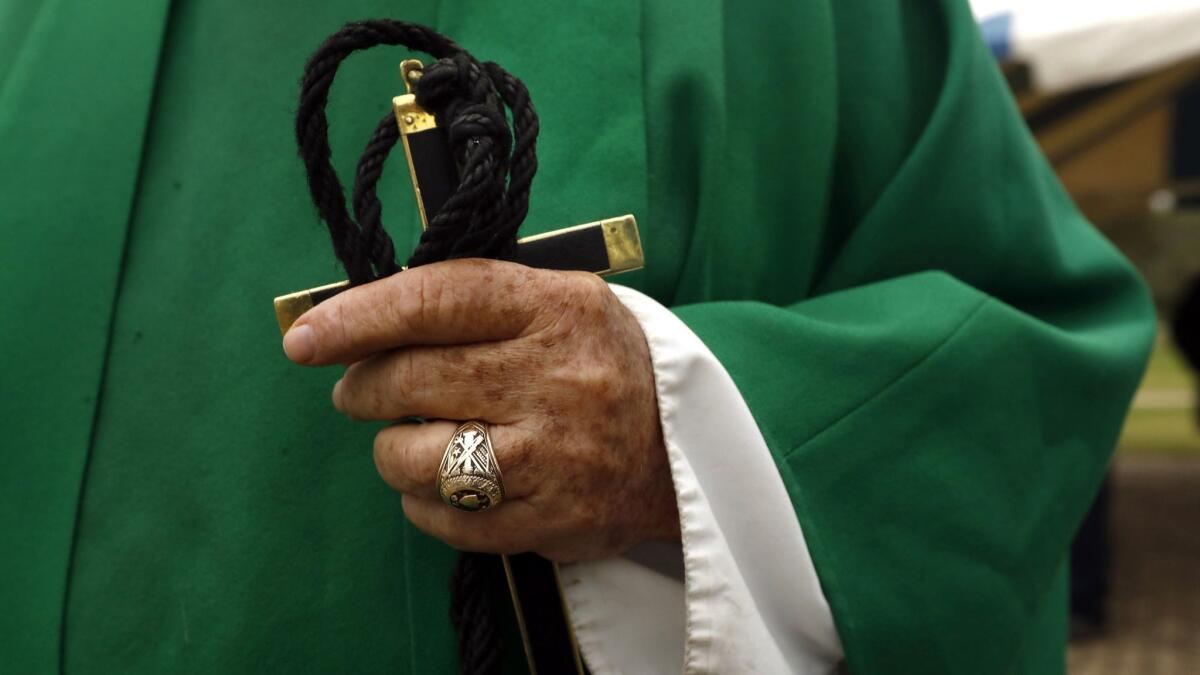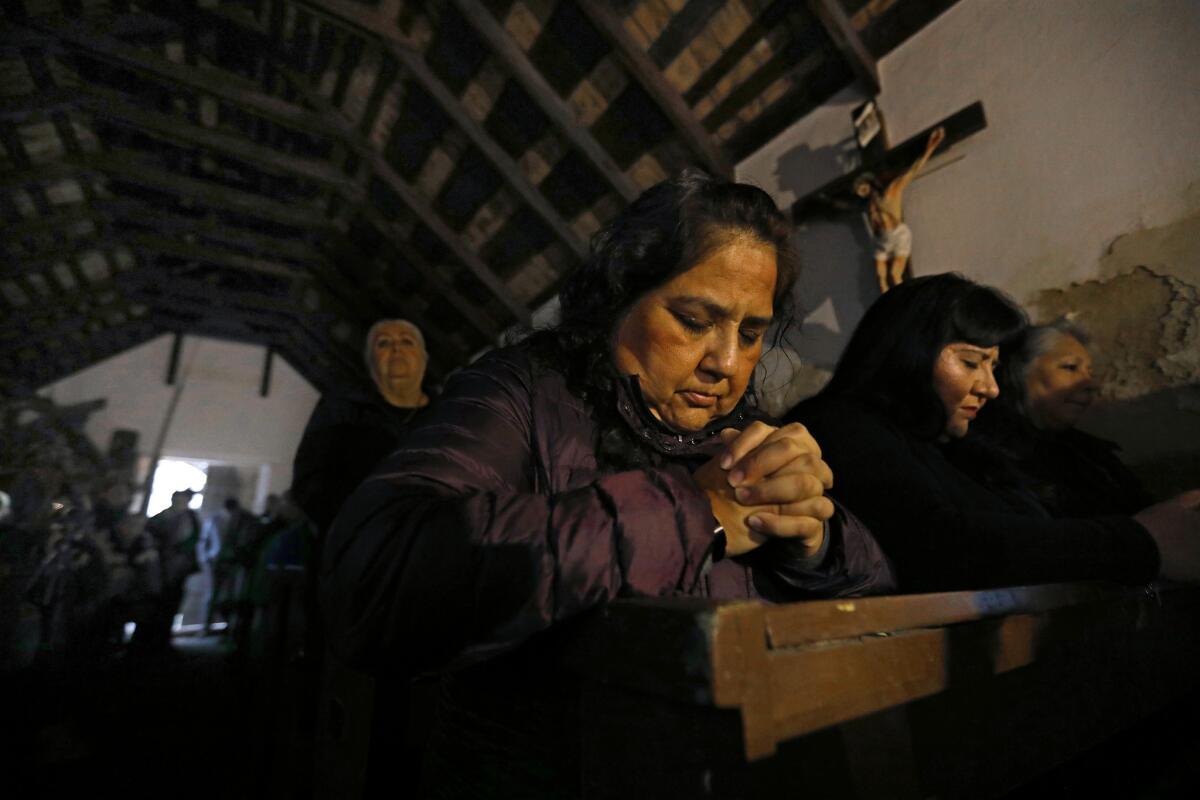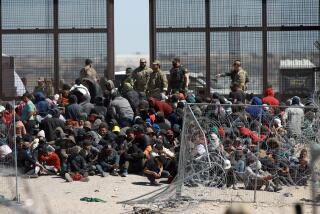A border fence could seal off this tiny Texas chapel, but its worshipers aren’t giving up

The faithful prayed at La Lomita chapel before dawn Friday, asking that a new border fence not seal off access to the 19th-century church in Mission, Texas.
Dozens of people packed into the one-room chapel Friday to pray that the 19th century mission known as La Lomita, perched on a hill above the Rio Grande, won’t be sealed off behind a border fence.
Worshipers bowed their heads during the Catholic novena prayer vigil, the latest of nine Masses Father Roy Snipes has held to oppose to the fence. The mayor of the town of Mission, his wife and the city manager stood with them among the rustic pews, and several police officers watched with the overflow crowd outside.
A Border Patrol agent sat in a marked SUV on a nearby levee, where the fence would be built, and watched.
“Never did we contemplate a wall” rising nearby, the priest said.
Snipes — known as “the cowboy priest” for his Stetson and pack of adopted stray dogs — prayed in a mix of English and Spanish.
“Between reflection and hysteria and whatever else, Lord, we pray to be true to ourselves,” Snipes, 73, told about 50 people in the chapel before blessing them with the holy water he draws from the river.
The modest sandstone chapel is caught between the coming fence — 18 feet high, made of steel bollards — and the Rio Grande, the dividing line between the U.S. and Mexico.
Landowners said they saw crews arrive to clear brush this week several miles west of La Lomita for construction of the fence. The $1.4-billion, 37-mile stretch of border barrier was funded by Congress last year. It is expected to rise atop the levee just north of the chapel, with a 150-foot “enforcement zone” to the south that would swallow the whitewashed outpost.

Snipes, who was ordained in the chapel in 1980, has been against the fence since October, when the Border Patrol filed a federal lawsuit to condemn land around the chapel and begin surveying.
He worries about the future of the mission, where he says priests once lived in a bunkhouse with stables and a blacksmith. He worries it would block access and scare away the faithful, most of whom are Latino.
Building a fence, let alone a wall, in the Rio Grande Valley is geographically tricky. The Rio Grande winds north and south, east and west, through what’s essentially a delta, around homes, farms, cemeteries, churches and other landmarks. That’s why much of the new fence will be built atop a levee, in some cases miles north of the river.
In the past, when the Border Patrol built fences in the valley north of homes and businesses, it installed locked gates and shared the combinations with property owners. Some complained the gates were left closed and restricted access to public sites, like parks. Others said they had a chilling effect, scaring people away who mistakenly believed land south of the fence was in Mexico.

In recent months, property owners along the planned path of the fence have been receiving letters from federal officials, but little information about construction plans. First, the letters asked for permission to survey. In some cases, they notified residents that the government was suing them in federal court to access the land.
More recently, they offered to buy some plots outright for about $32,000, a lowball offer considering the stakes. During the last major federal effort to survey and build in Texas’ Rio Grande Valley — in 2006 following the Secure Fence Act — property owners who hired attorneys sold their land for millions.
This time, many owners have already consented to have their land surveyed. Some are considering whether to sell or hire lawyers to negotiate.
Selling was not an option at La Lomita. The local bishop and diocese have fought the fence and the government efforts to survey. After the federal government sued to access the land, church attorneys argued that the fence would block access to the chapel, infringe on religious freedom and counteract the church’s message of inclusion.
A cowboy priest battles to protect 153-year-old Texas chapel from a border fence »
On Wednesday, U.S. District Judge Randy Crane in nearby McAllen ruled that government surveyors could access the church property on terms set by the local diocese. Crane said he has visited the chapel and that surveying wouldn’t constitute a “substantial burden” on religious freedom.
An attorney for the federal government said the 150-foot enforcement zone might be adjusted at La Lomita, according to a diocese attorney. Snipes, who had been at court, said he took that as encouraging news.
Border Patrol officials have not met with the priest or many other residents in the path of the fence to discuss their plans, despite repeated requests for public meetings. Officials have also declined to release updated maps of the project.
It wasn’t clear Friday when surveying would start at La Lomita, or how intrusive it would be. Carlos Diaz, a Border Patrol spokesman, declined to answer questions about the project, including whether there would be an enforcement zone at La Lomita or elsewhere, citing the pending federal lawsuit.
“The only disturbance will be if they rile the old ladies,” Snipes predicted as he stood outside La Lomita after Mass, referring to the women who attend services regularly. “I don’t know if you’ve ever riled a viejita, but they might give the surveyors a hard time.”
The priest said he was more worried about what comes after the survey for the fence, which he called “obnoxious and obscene.” The government could move to seize the land, as it has in other parts of the valley, claiming eminent domain.

The city of Mission draws its name from the chapel, a former mission for oblate priests like Snipes. Mission Mayor Armando “Mando” O’Cana, 64, a former altar boy, has belonged to the surrounding parish all of his life. The former educator and city councilman says he supports added border security, but he doesn’t want to see the chapel cut off behind a fence.
“It’s not only a physical barrier, it’s a symbol,” he said.
O’Cana, who like many in the valley describes himself as a “conservative Democrat,” told President Trump how he feels when he met the president during his visit to McAllen last month. The mayor also asked for more information about the fence project. Trump paid attention and directed an aide to follow up, O’Cana said. Ten days ago, the mayor met with the new Rio Grande Border Patrol chief, who promised the fence would not restrict access to the chapel.
“He sounded very sincere,” O’Cana said before leaving La Lomita to attend the Border Patrol chief’s first “state of the border” address at the local convention center.
Others lingered after Mass. The temperature had dipped overnight into the 40s, and the sun barely rose in a gray sky spitting rain. So they built a campfire outside the church entrance and sang a hymn as the priest blessed them again with Rio Grande holy water. Next to the chapel, the city had erected a blue and white striped tent, where volunteers set out Mexican hot chocolate, Shipley’s coffee, breakfast tacos, pan dulce and sugary, home-fried buñuelos.
Gracie Ramos and some childhood friends pulled folding chairs together to reminisce about “our Lomita.” They had worried they would find it closed, locked or blocked.
“We don’t want it to be isolated,” said Ramos, 69, a retired AT&T worker.
Until the issue is resolved, Snipes told those outside the church, he plans to continue holding Friday morning Masses at La Lomita in opposition to the fence.
“Saddle up,” he said, “And come on down.”
molly.hennessy-fiske@latimes.com
More to Read
Start your day right
Sign up for Essential California for news, features and recommendations from the L.A. Times and beyond in your inbox six days a week.
You may occasionally receive promotional content from the Los Angeles Times.







